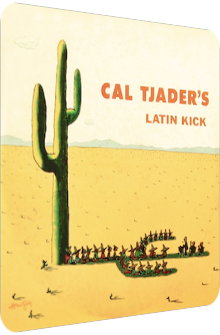
Cal Tjader
Latin Kick
1956
There is no denial whatsoever, vibraphonist Cal Tjader (1925–1982) is the king of synergies and fusions. This fact can only be embraced in regard to both his renditions and original takes, but proves to be problematic during an encounter of – or clash in – naming conventions. This happens on two levels concerning Latin Kick, recorded on three consecutive days in Los Angeles in May 1956 and released in the same year on Tjader's house label Fantasy. Firstly, Latin Kick's eleven songs – eight renditions and three unique cuts – are thematically spread all over the world and include songs about Paris and Vermont, despite the album title. Secondly, the album itself is not Latin at all, at least not in the classic sense! It is much more fond of that infant genre and soon-to-evolve craze called Exotica.
Cal Tjader leads a sextet on this record, with him on the vibes, Manuel Duran on the piano, Carlos Duran on bass, Brew Moore on the tenor sax as well as Bayardo Velarde on the timpani and Luis Miranda on the congas. Whatever one's personal definition of Latin music is, the following ingredients are not included here: sizzling-hot brass blasts, timbres of lovelorn devotion, inviting chants, labyrinthine tone sequences. Instead, the listener is lured by downtempo oases, snugly landscapes awash with moonlight and amicable tenor sax infusions that lack the bile and exhilaration of other Latin albums. The front and back covers, however, are definitely rooted in stereotypes, with poncho- and sombrero-wearing Mexicans sitting below a large cactus and talking about Tjader's album in a boldly Mexican accent as depicted on the backside of the cover. These are luckily the only questionable clichés on Tjader's very melodious and enchanting album. Its rhythmic changes never feel forceful, a lot of the songs surprisingly neglect Tjader's signature instrument altogether, and the mood is wondrously dreamy and genteel all of the time. Read more about one of the easily available but lost Exotica albums below.
The first event of every good Mexican fiesta launches with an Invitation. Bronislaw Kaper's classic has never been interpreted in this very way, though. Instead of loud horns and flamboyant rhythms, Tjader and band deliver a tremendously soothing midday mirage of coziness. The waves of the cymbals soon mesh with a gorgeous vibe-piano melody that neglects any trace of Latinism. Cal Tjader and pianist Manuel Duran are accompanied by Luis Miranda's conga beats and Carlos Duran's mellow double bass. Best of all, however, is the mystified glissando of the vibraphone. It towers above the warmhearted atmosphere and yet remains harmoniously attached to earth, delivering only traces of Space-Age and Exotica. Latin Kick thus starts in a gorgeous way, becomes ever so slightly more vivid once Bayardo Velarde joins with his clanging timbales, but retains its laid-back aura. I consider this piece to be one of Cal Tjader's very best renditions ever!
The following Lover Come Back To Me by Oscar Hammerstein II and Sigmund Romberg puts Brew Moore and his tenor sax into the limelight and completely denies the vibraphone in favor of a delicately dense thicket of upbeat congas and timbales rounding off both the sax's impetus and the distant piano tercets. The saxophone is silky, definitely not harsh or acidic, the mood is uplifting and traversed by short percussion solo segues.
Kurt Weill's September Song immediately launches with the vibes. These encapsulate an autumnal feeling in their sustain and decay phases which is then aptly countered by the sun-dried piano chords and a decidedly hollow conga aorta. Cal Tjader simulates spiraling rain drops which are further boosted by rhythmic claves. The middle section sees an easygoing piano solo that is more about the accessibility of the melody than a convoluted setup before the rhythm is shortly changed in the final minute to a Merengue. These rhythmic changes do not feel forced, but add a certain verve and eclecticism to the song. Will You Still Be Mine by Matt Dennis and Tom Adair is the jazziest take of the album. It is still a tropical interpretation: Cal Tjader's vibes are again completely amiss, leaving Brew Moore's sax to fill the lead melody with life. A sunset-evoking aurora is maintained, the melodies are complex yet balmy, the congas, claves and shakers rev up the liveliness, but it is the playful second half with the shimmering orange hue of the good-natured piano melodies that outshines the saxophone-laden first half.
Side A closes with Cole Porter's I Love Paris, a questionable choice in the given theme of the album, but only on paper, for Tjader injects a – as I often tend to write – jungular feeling to this classic. Green-tinged polyphonous vibes offer a new flavor and color range to the album, Latin piano sequences destroy any thematic connections to Paris, and the plasticity of the timbales and congas augments the feeling of a cruise through sun-lit groves. A Latin Exotica artifact of almost six minutes with an ever-shifting kaleidoscope of interplay and variety.
Side B opens with Cal Tjader's own Tropicana (later renamed to Tropicville) and offers a fleeting visit to Calypso-oid climes with steel pan-mimicking vibes, the swirling melodic traits of Trinidad and crunchy cowbells next to sizzling hi-hats and hollow congas. The melodies are hard to catch, as this jazzy piece is more about the textures, tempo and timbre than an omnipresent catchiness, or in short: this is a good example of Tjaderism. John Blackburn's and Karl Suessdorf's Moonlight In Vermont then proves to return to the scintillating Lounge mood of the opener by offering a glitzy – now nocturnal – phantasmagoria full of romance and carefreeness. Exotica fans and Lounge lizards ought to be pleased. While Bye Bye Blues by the quartet of writers Bert Lown, Chauncey Grey, David Bennet and Frederick Hamm turns to a Pérez Prado-esque saxophone arrangement in Tjader's hands complete with smarmy sax melodies, loud timbales and Manuel Duran's lofty piano breezes, it is this pianist's own groove called Manuel's Mambo which ventures into Far Eastern spy theme realms; the vibes comprise that certain sleaziness in-between a piano-underpinned conga groove. Both the piano and the vibe play in higher tone regions, adding much to the perceived translucency of Manuel's Mambo.
Jerome Kern's and Oscar Hammerstein II's All The Things You Are then offers a sunrise Salsa with wildly oscillating vibraphone sparks and sun-coated piano foils that is both exotic-easygoing and bases its setting on a lively midtempo, with the final treat Blues From Havana coming from Cal Tjader's feather and offering another duskier but festive twilight state with saxophone drops, conga driblets and Carlos Duran's double bass slaps. It is a surprisingly underwhelming outro, much more rooted in Harlem than Havana. But given the timbales and congas, it does nonetheless live up to the mildly Latin and strongly exotic topos.
Latin Kick is a highly synergetic but cohesive work. That the album is christened Latin Kick is an unfortunate state of affairs, for there is hardly ever a glaringly Latin spirit interwoven, a missing trait that Tjader's work shares both title- and music-wise with Barney Kessel's Exotica (!) album Contemporary Latin Rhythms (1963). No brass eruptions stab the listener, no short chants or exclamations transport a clichéd but working joy of life, the incessant and utterly welcome stream of congas, timbales, cowbells, and claves is purely exotic, but the most impressive aspect is found in the year this gem is released: 1956 is pretty much a pre-Exotica year, with Martin Denny quasi-secretly preparing the genre's cornerstone called – who would have thought it – Exotica in December of 1956 only. Tjader and his band are keen to offer some sort of fusion, and while the Exotica genre borrows heavily from Latin rhythms, related percussion instruments and timbres, Latin Kick always feels like seeing the Latin genre from an exotic viewpoint rather than being willed to aurally depict a faithful take on that Latin feeling, whatever the interpretation may be.
But no, Tjader decidedly transfigures the then-current state of Latin music and even offers a stricter focus on melodies. And another surprise is embedded in Latin Kick, as stated in this review's opening paragraph: songs about Europe. The order of sequences is thus as follows: (partially) European compositions are Latinized. And these Latinizations are then exotified. Fans of Cal Tjader own this anyway, but those who want to find another Exotica album that is camouflaged by its presented material and its title will be surprised to find such a melodious album. I also recommend Tjader's two-part counterpoint Demasiado Caliente (1960) which features two different recording sessions with an even stronger focus on frantic, eclectic percussion schemes. Latin Kick is available on LP, CD and as a digital download.
Exotica Review 335: Cal Tjader – Latin Kick (1956). Originally published on Apr. 26, 2014 at AmbientExotica.com.
